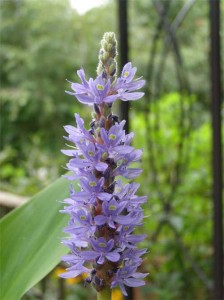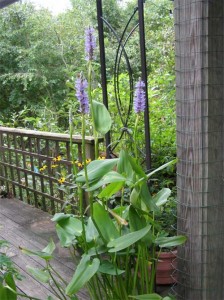Pickerelweed in a pot
By Ken Moore
“An attractive perennial that grows in watery places in the swamps, usually reaching from one to four feet in height with showy spikes of blue flowers. A tea made from the root is supposed to be a good cathartic. The plant is becoming very popular for garden pools. My wife and I planted several of them near a spring below the house.â€
That is Paul Green’s description of pickerelweed, Pontederia cordata, from Paul Green’s Plant Book. I am repeatedly drawn to the plant notes from his daily observations and conversations with the local folks of the Cape Fear River valley, from Chapel Hill down through Lillington, Fayetteville and beyond. Plants take on a special dimension when accompanied with past and present human associations.
All summer, I have been enjoying the blue flowers and glossy-green leaves of this emergent aquatic. I have it growing in competition with water-dragon, also called lizard’s-tail (see Flora, 6/18/09), and cattail in a little pond that is slowly progressing to a cattail-dominated wetland. I also have the pickerelweed happily growing in pots submerged in plastic wading pools scattered around the yard.
None, however, bring me the up-close pleasure of having a water-filled pot of pickerelweed on the deck right outside the back door.
My deck plant is about to burst out of its pot, so this fall I will pull it out of its confinement and divide it into two or three additional water-filled containers. Few other plants, native or exotic, bring such continuous visual pleasure, and native pollinators love it.
The individual flowers have a superficial resemblance to orchids; and each day I take that “closer look,†I just want to pull up a stool and gaze at them until they begin to close in the early afternoon!
You’ll find it in the wild, growing along edges of rivers and ponds throughout the eastern U.S. The common name, pickerelweed, refers to the pickerel fish, which feed along the edges of such emergent aquatic vegetation.
I’ve recently learned that pickerelweed is a tasty edible. The young unfurled leaves can be chopped to add to salads or boiled and served with butter. Peterson’s Edible Wild Plants guide also describes that the ripe nut-like seed is nutritious eaten raw or dried and added to granola or roasted and ground into flour. Plan on getting mighty wet wading around in swampland to collect enough seed for making flour. I’m not going for the flour, but with the few plants I have close at hand I think I’ll pay closer attention to the maturing seed and make my own taste test.
If you’re keen to have a pot or two of your own, ask your favorite garden center to get some.
Nurseries that stock water lilies usually also stock some of the other interesting emergent aquatics that are suitable for home water gardens.




Trackbacks and Pingbacks
Comments are closed.